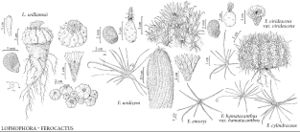Lophophora williamsii
Contr. U.S. Natl. Herb. 3: 131. 1894.
Plants 0–50-branched, nearly flush with soil surface. Roots fleshy, broadly carrot-shaped, 6–12 cm. Stems flat or domelike with deeply depressed center; ribs to 25 mm broad. Flowers: outer tepals narrowly elliptic to oblanceolate, apex acute, mucronate; inner tepals elliptic, margins white to greenish pink, midstripes darker, apex mucronate or attenuate; ovary 3–4.5 mm; styles white, 5–14 mm. 2n = 22.
Phenology: Flowering Mar–May(-Sep).
Habitat: Chihuahuan desert scrub, Tamaulipan thorn scrub, usually on or near limestone hills
Elevation: 100-1500[-1900] m
Distribution

Tex., Mexico (Chihuahua), Mexico (Coahuila), Mexico (Nuevo León), Mexico (San Luis Potosí), Mexico (Tamaulipas), Mexico (Zacatecas)
Discussion
Long used for religious and medicinal purposes by native peoples, Lophophora williamsii is famous for its psychoactive alkaloids, primarily mescaline, which are concentrated in the small, photosynthetic, above-ground portion of the stem. Experienced peyoteros harvest only the top few millimeters of the stem, leaving the deeply recessed apical meristem, thus allowing regeneration. The plants live for many decades and grow very slowly. Anhalonium, a later name for Ariocarpus, has been applied to species of Lophophora, and was widely used in older pharmaceutical literature.
Fruits abruptly ripen up to one year (rarely longer) after flowering.
Selected References
None.
